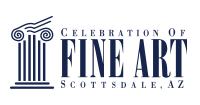Just like his work, artist Pete Tillack is deeply introspective. He spends a lot of time contemplating life––the lessons, failures, fears, losses, celebrations, and the list goes on. While reflection can be time well spent for anyone, for Pete it also helps shape his body of work.
His paintings are embedded with various objects––seemingly random pieces of furniture, animals, graffiti, books, etc.––that imbue deep meanings. The combination of objects all work together to communicate a message––tapping into what it means to be human. Pete’s work often reflects back the deep emotions, fears and desires we all experience. And this is exactly what draws so many collectors and admirers to his work––a sense of connection.
Looking at Pete’s body of work, it seems to flow from him so effortlessly. But it took years of committed work for him to find his voice. Pete will also be the first to tell you he was not a natural-born artist. That, too, took years of hard work. It was through that struggle and sacrifice, however, that he discovered if he was going to succeed as an artist he had to get honest with himself and paint from his true emotion.
Once he realized that, his work started to connect with people. And for Pete, it’s that sense of connection that compels him to keep creating art.
Q&A with Pete Tillack
When did you know art was your calling?
It was gradual, but it was in my late 20s. It [art] was introduced to me and I had to work at it to find the creativity. I sort of liked it and just worked and worked and worked. Many people often ask or talk about talent––and there’s something about talent and skill. Skill is something you constantly work at, and that’s what I did.
How did you develop your unique style?
I found my voice through exactly what my paintings talk about. It was through one of the failures––not being able to support the family and struggling to connect with people. When I was honest with myself and started painting my true emotions, it really came about. The pieces really started to evolve when I started telling the stories behind it––of my fears. When I related my fears into my paintings, then success followed and it became the connection. So I talk about that––the relationship between fear and success or going for it or being torn in a society.
What is the most rewarding aspect of what you do?
Being able to connect with people. Whether or not that connection is through somebody who ends up purchasing a piece because they’ve connected to it. I get the question, ‘How do you let go of something that you’ve created?’ I think it’s an honor to have somebody take one of my pieces home and put it in their home. It’s something pretty stoked to have that, and I have trouble sometimes realizing that I painted the piece.
It sometimes takes a while for me to actually appreciate it because everything I see, there’s always a failure. But if I ever was to connect with perfection, I think that would be––in my own eyes, my perfection––it would be difficult. What do you do once you hit perfect? I like that I don’t always see something as perfect. I like those challenges of constantly finding another level of art. It’s constantly evolving with that. So I’ll spend a lot of hours just sitting there redefining things.
What do you love most about the creative process?
The act of creating in itself is a challenge, and that’s one of the things I talk about. What is life without a challenge? And there are different parts of this, as a business, where if I’m not in the mood to paint, I can change over and find a challenge somewhere else, whether it be the business side of it or the creative side. But when I’m at a painting, it’s one of the few things that I can really be involved in and work for hours just challenging myself to find how I’m going to create the three-dimensional objects and how do I tell the story. I find it very captivating. It’s one of the few things where sometimes I don’t even want to listen to music. I don’t want any input outside of my own thoughts in my head.
How do you create a sense of connection with your work?
Each piece has a story and a reason why I put things in there. I think very deeply about that. I get asked a lot about somebody’s interpretation, and that’s not necessarily the meaning. It’s an interpretation. I have a direct meaning of each piece and why I put it there. Now, if you have an interpretation, that’s fine, but when they connect with that or they bring in their own interpretation, there’s something interesting about that and it’s interesting to hear their views.
But it doesn’t always connect everything because there are so many different elements in my pieces and when they hear the meaning, they often have an “aha” moment, as if they were the only ones that felt that way. If they had that fear and were able to overcome it, I think that alone is a connection. It’s like that song that we listen to over and over again that we feel is sung to us, and we gravitate towards that. We put a theme of our life to that, and it builds who we are.
What brings you to the Celebration of Fine Art?
I’ve been doing this for about 12 years. There are sacrifices. I sacrifice the things I love––walking away from my family in order to create a living that supports my family. I love my ocean, I miss that. But there’s the element of being amongst artists. There’s the element, that this show gives as artists, not only the financial side of it, but the creative side. I get instant feedback. There’s no way I could have created this without having the element of being live and getting instant feedback. There’s nothing worse than creating a body of work in your studio and then opening up to the recognition of it not really connecting.
Here, you see whether it connects straight away, and that’s one of the gifts of this show. Then to have people purchase your work as you’re painting it and talking about it as you’re painting it––that doesn’t happen in the studio. It’s a different feeling. I love being in front of my easel alone in my own mind, but to have people behind you going, ‘Oh, that’s really cool,’ you realize that you’re hitting another element and it really does push you to the next level. It is an interesting feeling. There’s a work element and a creative element to this show, and I think that’s something that’s so special and unique here.

